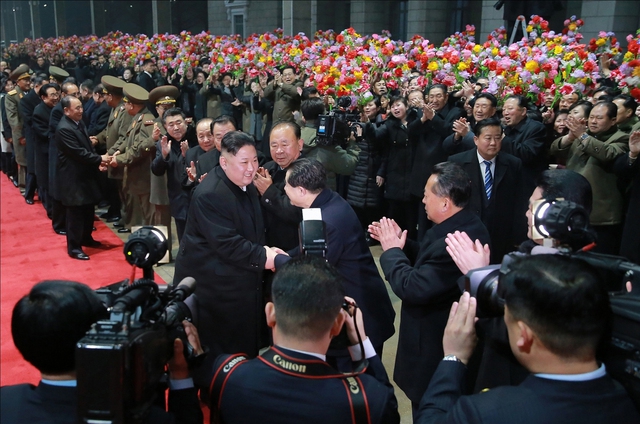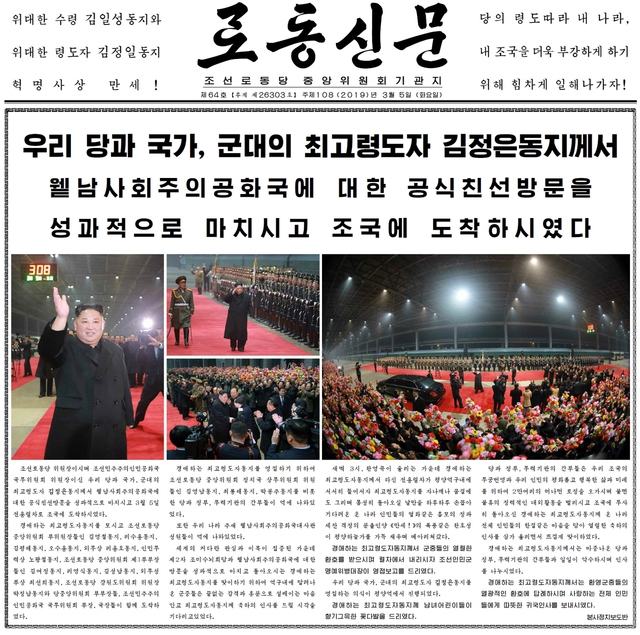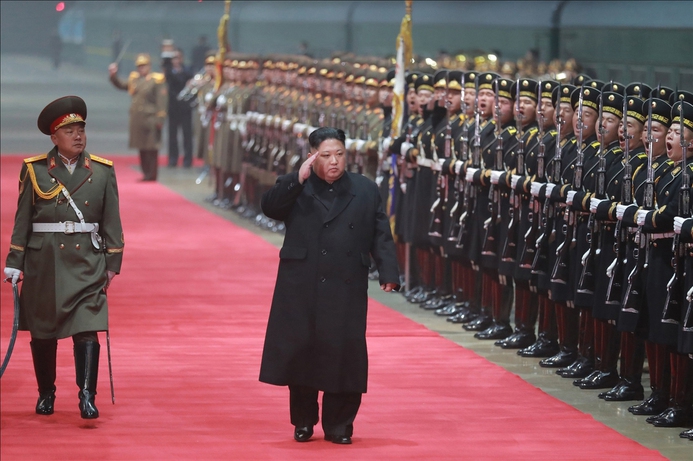Posted on : Mar.6,2019 17:31 KST
Modified on : Mar.6,2019 17:33 KST
 |
|
North Korean leader Kim Jong-un is greeted by high-ranking officials upon his arrival at Pyongyang Station on Mar. 5. (Yonhap News)
|
Rodong Sinmun trips as a patriotic odyssey on behalf of North Korea’s prosperity
After an 11-day railway odyssey, North Korean leader Kim Jong-un arrived in Pyongyang on Mar. 5. North Korea’s state-run newspaper the Rodong Sinmun said in a front-page story that Kim had “returned from a distant journey of more than 20,000 ri [7854.54km] after successfully completing a second summit with the US and a visit to the Socialist Republic of Vietnam.” The newspaper described Kim’s 11-day trip as his “tireless activity overseas [. . .] on behalf of the eternal prosperity of the fatherland, its future, and the peaceful and happy lives of the North Korean people.” The newspaper also ran four photographs showing Kim smiling and waving at the crowds gathered to welcome him at Pyongyang railway station.
 |
|
The front page of the Mar. 5 edition of the Rodong Sinmun. (Yonhap News)
|
The Rodong Sinmun reported that Kim’s personal train arrived at the railway station at “3 am” at Mar. 5 – 226 hours and 30 minutes after its departure from Pyongyang at 4:30 pm on Feb. 23. The keywords offered by the newspaper for Kim’s journey were patriotism (“strength and prosperity of the fatherland”), love of his people (“the peaceful and happy lives of the North Korean people”), dedication (“tireless and energetic activity overseas”), and the future. The message of this propaganda is that Kim is dedicating himself to his country and to the future of its people. This is in line with the column by Workers’ Party of Korea (WPK) Central Committee Vice Chairman Pak Thae-song that ran on the front page of the Feb. 25 edition of the Rodong Sinmun, in which Pak said that Kim’s trip to Hanoi was a “great journey of patriotism and love for his people.”
This suggests that the reason Kim chose to spend 11 days on a train when he could have easily covered the same distance by 10 hours in the air is to underscore his image as a dedicated leader who neither rests nor sleeps. A long train journey symbolizes the leader’s dedication, just as when Kim’s father and predecessor, Kim Jong-il, visited Russia by traveling across Siberia, a distance of 20,000km, between July 26 and Aug. 18, 2001.
Train journey demonstrates North Korea-China cooperation
Considering that Kim’s round trip through inland China necessitated the full cooperation and support of the Chinese leadership, it also had a performative aspect that emphasized that North Korea and China are on the same team. Koo Kab-woo, professor at the University of North Korean Studies, assessed this as being “North Korea’s version of ‘balanced diplomacy.’”
Kim didn’t tour any industrial sites in Vietnam or China. Many analysts think that this had nothing to do with the lack of an agreement in his summit with the US in Hanoi. Kim did say during his meeting with Vietnamese President Nguyen Phu Trong on Mar. 1 that he wanted “a new and higher level of development in every area, including the economy, technology and national defense.” This implies that Kim will keep Vietnam’s policy of reform and opening, known as Doi Moi, in mind while implementing North Korea’s policy focus on the economy.
The Rodong Sinmun roped together Kim’s summits with the US and Vietnam as both being “successful” without going into the details. That strikes quite a different tone from Pak Thae-song’s praise of Kim’s trip to Hanoi before the summit as being a “historic happening.”
 |
|
North Korean leader Kim Jong-un is saluted by his honor guard upon his arrival at Pyongyang Station on Mar. 5. (Yonhap News)
|
In its Mar. 1 edition, the Rodong Sinmun ran an editorial about the second national convention of low-level party propaganda officials that criticized “using hostile forces’ sanctions schemes as a ready-made excuse for justifying sluggish and poor work on our projects” as “craven defeatism and a surrender-oriented mentality.” The editorial also called for a “massive bootstrapping drive.” This presumably is an attempt to lift spirits and encourage unity at home, on the assumption that the UN and US sanctions won’t be lifted anytime soon.
By Lee Je-hun, senior staff writer
Please direct comments or questions to [english@hani.co.kr]











